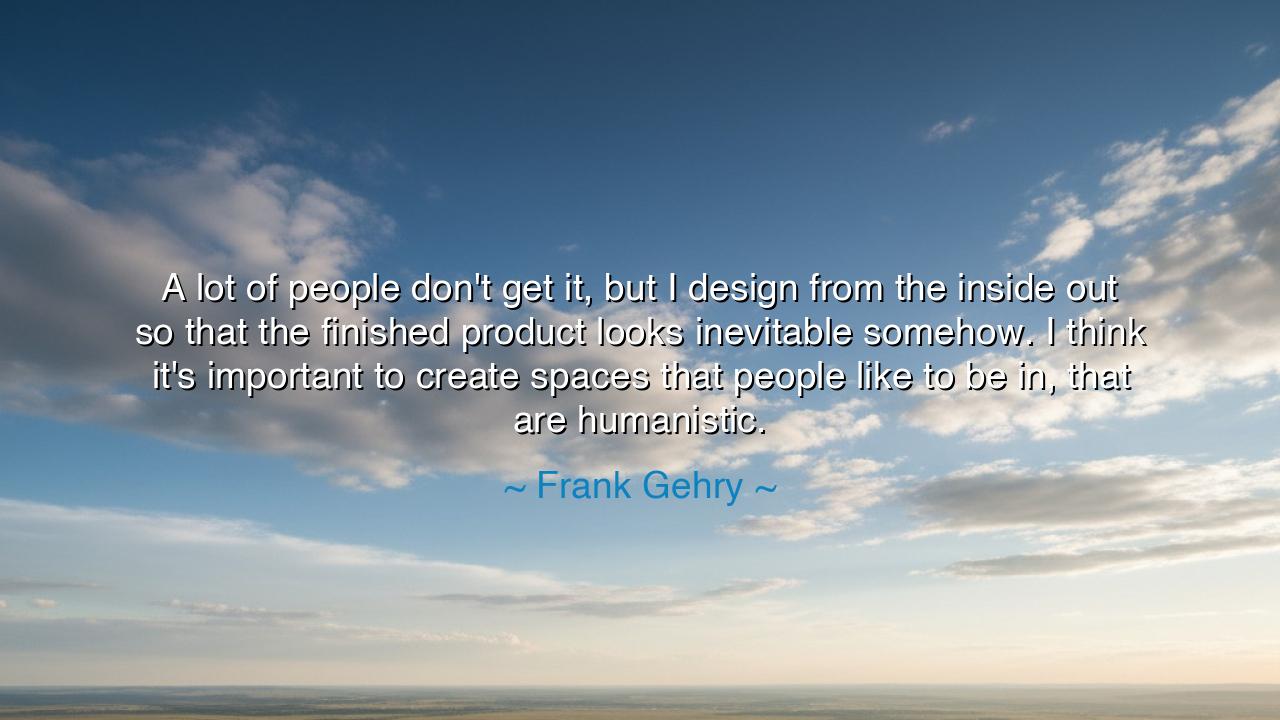
A lot of people don't get it, but I design from the inside out so
A lot of people don't get it, but I design from the inside out so that the finished product looks inevitable somehow. I think it's important to create spaces that people like to be in, that are humanistic.






“A lot of people don’t get it, but I design from the inside out so that the finished product looks inevitable somehow. I think it’s important to create spaces that people like to be in, that are humanistic.” – Frank Gehry
In these words, Frank Gehry, the master architect of flowing forms and luminous dreams, unveils the sacred principle that guides all true creation: that beauty must be born from within. He speaks not only of buildings, but of the essence of design itself, which begins in the heart of purpose and grows outward until form and function become one. To “design from the inside out” is to listen to the spirit of the space — to understand the needs, emotions, and rhythms of the human beings who will dwell within it — and only then to give it shape. Gehry reminds us that art and architecture are not ornaments of life, but expressions of life itself.
When Gehry says that his buildings “look inevitable somehow,” he reveals a profound truth about authentic design. For when a creation truly grows from within, when every curve, every light, every shadow arises from necessity and harmony, it no longer seems constructed — it seems destined. The observer feels not surprise, but recognition, as though the structure had always been waiting to exist, as though it had emerged from the earth itself. Such is the mark of great art, whether it be a building, a poem, or a life — it appears effortless because it was created with purpose, not pretense. The inevitable is not the result of force, but of alignment between idea, form, and soul.
The origin of Gehry’s philosophy lies in his rebellion against the cold perfection of modernist design — a movement that prized logic and uniformity above emotion. He sought to bring warmth back into architecture, to make spaces not for machines but for human beings. From the shimmering sails of the Guggenheim Museum in Bilbao to the rippling surfaces of the Walt Disney Concert Hall, his works do not conform to rigid geometry. They live and breathe, reflecting the unpredictability of life itself. His buildings twist, flow, and unfold as though shaped by wind and music. And yet, within their daring forms, there lies a profound humanistic order — a harmony between the structure and those who inhabit it. This is what it means to design from the inside out: to begin not with appearance, but with experience.
Consider the Guggenheim Bilbao, one of Gehry’s most celebrated creations. When it first rose upon the banks of the Nervión River, critics called it impossible, absurd — a mass of metal and light that seemed to defy all logic. But when it opened, the people who entered did not feel alienated. They felt awe. The interior, with its vast openness and gentle flow, felt alive — like standing within a sculpture of wind. It transformed not only the city’s skyline but its spirit, reviving Bilbao from industrial decline into a cultural renaissance. This was Gehry’s philosophy made manifest: a space designed for life, not spectacle, born from the heart outward, until it became something inevitable, timeless, and human.
To call a design humanistic is to say that it honors the dignity of those who dwell within it. In an age where buildings often rise like monuments to ego or profit, Gehry calls for something far greater: the architecture of empathy. A building should not dominate its inhabitants, but embrace them. A space should not merely impress, but comfort, inspire, and connect. The same is true of every act of creation — whether one builds homes, companies, or relationships. To create well is to remember the human heart at the center of all things. Without that, all design, no matter how beautiful, is hollow.
This philosophy transcends architecture and reaches into life itself. To live “from the inside out” is to shape one’s world from the core of authenticity — to let values, not vanity, be the blueprint. It is to build one’s actions upon compassion, one’s decisions upon truth, and one’s relationships upon understanding. When one lives this way, life itself begins to look inevitable — not as fate imposed, but as destiny fulfilled. Just as Gehry’s buildings grow from purpose into beauty, so too does a life built from inner integrity unfold naturally into meaning.
So, dear listener, remember Gehry’s wisdom: build from the inside out. Whatever you create — a home, a career, a dream — let it begin with truth and humanity. Let the structure of your work serve the life within it. Be not seduced by surface or spectacle, for these fade like reflections in still water. Instead, design your world as Gehry designs his — with courage, with care, with reverence for those who will inhabit it. For when you build from the heart, the result will not only be beautiful — it will be inevitable, and it will endure.
And in that harmony of form and feeling, of purpose and presence, you will have touched what Gehry calls the highest art of all: to create spaces — in stone or in soul — where humanity itself can breathe freely and belong.






AAdministratorAdministrator
Welcome, honored guests. Please leave a comment, we will respond soon